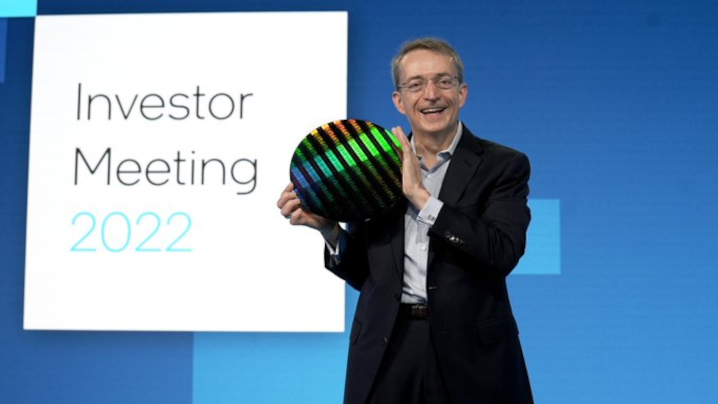 INFRA
INFRA
 INFRA
INFRA
 INFRA
INFRA
Intel Corp. today held its 2022 Investor Meeting, where executives detailed the new chips and semiconductor manufacturing technologies that the company plans to roll out in the coming years.
Intel’s key objective for its chip development efforts is to regain industry leadership in transistor performance per watt by 2025. In the longer term, the company aims to start making processing devices with about 1 trillion transistors by the end of the decade.
Executives also shared new information about Intel’s plans for the more immediate future. On the agenda: multiple new chips, including a data center processor that will combine elements of a graphics processing unit and a central processing unit. On the manufacturing side, Intel shared details about its forthcoming seven-nanometer chip fabrication process, including what performance improvements users can expect.
Intel’s newest and most sophisticated CPUs are based on a 10-nanometer process. The company is currently working to upgrade its chip fabrication facilities to newer seven-nanometer technology that it dubs Intel 4.
Intel stated that it expects Intel 4 to become “manufacturing-ready” in the second half of 2022. According to the company, chips based on the process will provide 20% higher transistor performance per watt than its current-generation silicon.
Intel 4 is particularly notable because it’s the first Intel process to use extreme ultraviolet lithography, or EUV, technology. EUV is a chip manufacturing method that uses beams of laser light to carve transistors into silicon wafers. Intel’s major rivals already use the technology in production.
The EUV-powered Intel 4 process is set to be followed in the second half of 2023 by Intel 3, an even more advanced manufacturing technology. Intel 3 is set to provide a further 18% increase in performance per watt for the company’s chips.
The next two manufacturing processes on Intel’s roadmap are referred to as Intel 20A and Intel 18A. Intel 20A is expected to launch first, in the first half of 2024, and the company said today that customers can expect an up to 15% improvement in performance per watt. Intel 18A, in turn, will deliver a further speed boost of 10% when it achieves manufacturing-ready status during the second half of 2024.
A major focus of Intel’s 2022 Investor Meeting was its Accelerated Computing Systems and Graphics Group, or AXG as it’s commonly referred to by the company. Intel formed AGX last year to lead development of its supercomputing chips and GPUs. The unit also manages the company’s recently announced initiative to build blockchain accelerators.
Intel told investors that it expects AGX to generate more than $1 billion in revenue this year. The company expects that number to grow to $10 billion in 2026.
GPUs will be a major contributor to the more than $1 billion in revenue AGX is set to generate this year. Last August, Intel announced plans to take on GPU market leader Nvidia Corp. by launching standalone graphics cards for the consumer and data center markets. Today, Intel provided an update on the effort, disclosing that it expects to ship more than four million graphics cards in 2022.
The company said that the first notebooks to feature its standalone GPUs will launch this quarter. The first desktops equipped with Intel graphics cards will reportedly follow in the second quarter.
Intel’s first laptop and desktop GPU series is codenamed Alchemist. According to the company, Alchemist will be followed by a second-generation GPU line in 2023 or 2024 that will target the video game enthusiast market. A third-generation graphics card series, dubbed Celestial, will launch in 2024 at the earliest with a focus on what Intel describes as the ultra enthusiast market.
On the occasion, Intel also shared details about two upcoming additions to its data center GPU portfolio.
Arctic Sound-M is an upcoming data center graphics card with a hardware-based AV1 video encoder module. It will target use cases such as video content processing and cloud-based game streaming, with Intel promising a 30% improvement in bandwidth compared with current silicon. The company hopes to start shipping the chip in the middle of this year.
Further down the line, Intel plans to introduce a new type of processor called Falcon Shores. It will combine CPU and GPU elements in a single package, the company said. When the processor launches in 2204, Intel says that it will provide five times better performance per watt, compute density and memory capacity than current products on the market.
Intel today also shared an update about its Intel Foundry Services, or IFS business, which will use the company’s chip fabs to make custom processors for other organizations. Intel disclosed that IFS is launching a dedicated automotive group to make chips or automakers.
IFS is developing a “high-performance open auto compute platform” for use in vehicles, Intel said. The platform will allow automakers to combine multiple types of processing modules, such as GPUs and CPUs, in a single system by making use of Intel’s chiplet technology. IFS will not only manufacture chips for automakers but also help them with processor design, Intel stated.
The auto sector has become a bigger focus for other major players in the semiconductor market as well. Qualcomm Inc. last October teamed up with investment firm SSW Partners to acquire Veoneer Inc., a Stockholm-based smart car technology supplier, in a deal worth $4.6 billion. More recently, the company announced a partnership with General Motors Co. to develop a driver assistance system that uses systems-on-chip from its Snapdragon processor line.
Intel’s move to increase its focus on the auto sector may create more competition for Qualcomm, as well as Nvidia. The latter company provides a series of processing modules for autonomous vehicles.
THANK YOU